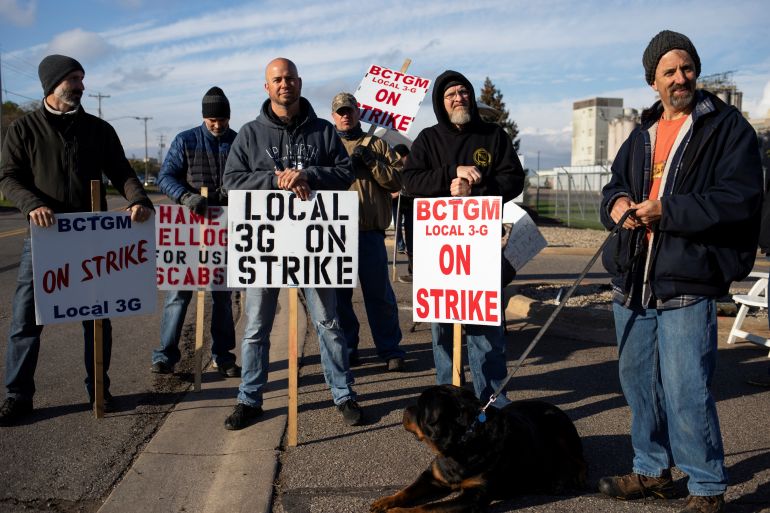‘Striketober’ can be a turning point for the US Labour movement
Dubbed ‘striketober’ by activists and pundits alike, a strike wave is occurring across the country, in various industries.

Typically, the US is not considered a hotbed of labour unrest. Yet this is precisely what we are seeing as, during the month of October, more than 100,000 workers have either threatened to strike or have actually walked off the job to demand wage increases, improvements in their working conditions, and basic human dignity.
Dubbed “striketober” by activists and pundits alike, this strike wave is occurring across the country, in various industries. From workers at a John Deere factory in the midwestern state of Iowa, which produces farm equipment, to nurses at Kaiser Permanente in California and Oregon, people in diverse professions are taking matters into their own hands and demanding changes to improve their lives.
Keep reading
list of 4 items‘Pure veg fleet’: How Indian food app Zomato sparked a caste, purity debate
Trapped, abandoned: Filipino workers lured to Poland by shadowy agents
EU countries endorse diluted draft rules on gig economy workers’ rights
These workers are also doing something else, namely, showing a certain strategic brilliance in choosing now as the time to walk off the job.
There is a chronic labour shortage in the US, and these striking workers are thereby taking an already bad situation for employers and making it worse.
The causes of this shortage are many.
Some claim that, with the Biden administration distributing payments as part of the COVID-19 stimulus, workers are choosing to stay at home instead of rejoining the workforce. Assigning blame to the government in this way misses other, more likely explanations, not to mention the fact that this kind of claim is a red herring for anti-government conservative calls to cut public policy across the board. There is also the reality that government payments have equalled pre-pandemic average wages in only three states.
Better explanations include how the pandemic caused a significant shift in labour relations, with workers changing jobs as many have decided to take jobs online, while others have opened small businesses. Retiring workers, some for fear of contracting COVID-19, as well as tough immigration requirements, have been seen as contributing factors that have created vacancies in the American workplace.
The strikers also have a certain legitimacy created by the COVID-19 pandemic as these workers have kept the country going while millions sheltered in place. Some of the nurses going out on strike have staffed intensive care units during the worst days of the pandemic. Who, honestly, can find fault with these care workers who have risen to the occasion day in and day out for the past year and a half?
The same can also be said of any of the other workers who were deemed “essential” by government authorities. From farmworkers to grocery store employees, millions in the US have had to labour as COVID-19 created undue stress in their place of employment.
Importantly, “striketober” is different to mass actions previously seen in the country in another critical way.
Consider the many protests that took place when Donald Trump was president. Immediately after the former president’s inauguration in 2017, there was the Women’s March, which saw thousands of people take to the streets to denounce Trump and his incoming administration. Like the strikes taking place now, these were held in cities across the nation. But there is a key difference. For all the disgust and anger they mobilised, the Women’s Marches only took place for a day.
Similar kinds of actions in the past – such as “A Day without Immigrants” which demanded reforms to the US’s immigration laws – have also been called for just one day.
Holding one-day protests may briefly call attention to a cause, but they are too easily ignored by authorities. Sure, dramatic footage of the mass actions will be broadcast in the 24-hour news cycle, but as soon as the public’s attention is grabbed by other headlines, interest shifts to the next shocking thing in the news.
Meanwhile, authorities can turn away and ignore the protests with ease, no matter their size or righteousness of their cause, because no real pressure has been brought.
But the workers going on strike now are not doing it for just a day. The strike will end when negotiations end. Perhaps that point will be reached in a week, a month, or a year. And this is central to the strategic lesson – no deadline has been announced beforehand.
For the first time in decades, US workers have leverage. The question now is whether workers in other industries will join the strike. With supply chain disruptions remaining an issue around the country, will additional organised and unorganised labourers also seize this moment and use their leverage to make their voices heard?
The truth in the US is that impasses in debates involving the need to improve the country’s healthcare system, reform its immigration policy, and raise the minimum wage have gone on for too long. Perhaps the “striketober” efforts themselves, as well as other movements that may draw inspiration from the strikers for future actions, will pressure authorities for real change.
The views expressed in this article are the author’s own and do not necessarily reflect Al Jazeera’s editorial stance.
